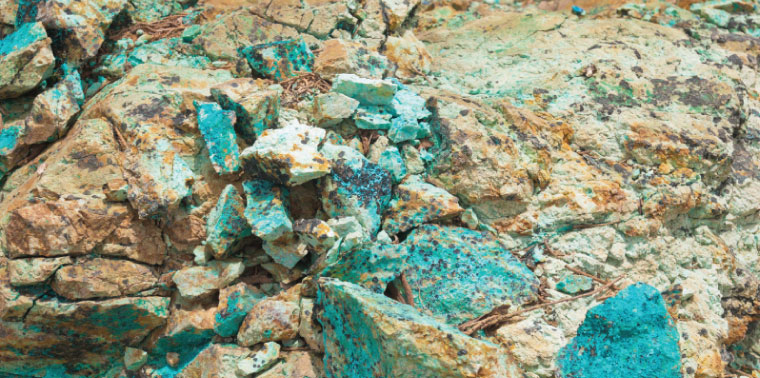July 23, 2013 — These days it seems as though just about every enterprise, from the corner store to multinational investment firms, is pursuing sustainability. Exactly what that means varies, but definitions seem to more or less be about meeting current needs (and wants) in a way that doesn’t compromise the ability of future generations to do the same. One area where there is much debate around our ability to do so is in mineral extraction, which by its nature involves using nonrenewable natural resources. Can mining be done sustainably? Saleem H. Ali, director of the Centre for Social Responsibility in Mining at the University of Queensland, Australia, and Jamie Kneen, communications and outreach coordinator for MiningWatch Canada, provide two perspectives on that perplexing question.
Saleem H. Ali
Director, Centre for Social Responsibility in Mining
University of Queensland, Australia
“The term ‘mineral’ is often used to define various naturally occurring materials extracted from the geological crust of the Earth. Yet, for questions of sustainability, we need to differentiate metallic minerals from nonmetallic ones, because ‘renewability’ for operational purposes will be defined by the level of entropy (or disorder) that mineral use will generate. The question of renewability from a chemical perspective is simply one of expending enough energy to bring back the material from a higher level of entropy to allow for reuse or recycling. Energy needed to counter the entropy created by the mineral’s use is the main metric to evaluate whether that material’s use is sustainable or not. From an operational perspective, metallic minerals are used in lower levels of entropy. That is why we are usually able to recycle them, whereas with minerals like coal, the use itself converts the material to such a high level of entropy (in the form of carbon dioxide) that it is essentially nonrenewable.
If we can design products that can retrieve minerals in usable form with relatively low energy expenditure and restorable environmental impact (particularly if the energy utilized for recycling is from renewable sources), then mineral usage is indeed sustainable. From an economic perspective, the extraction process of a finite resource from the Earth’s crust can still lead to sustainable development so long as the capital generated is invested in building a diversified economy. This ‘weak sustainability’ aspect also applies to fossil fuel-extraction economies, thus deeming them nonrenewable but sustainable.
Indeed, the natural resource base of some areas may necessitate mineral profits as the catalyst for a longer term development path. Rather than a simplistic rejection of minerals as ‘nonrenewable,’ environmentalists must be willing to grapple with the chemical, ecological and economic nuances of material extraction.”
Jamie Kneen
Communications and Outreach Coordinator
MiningWatch Canada
“Mining is inherently unsustainable: It is destructive to the biophysical environment, and its contributions to human well-being are uneven and often overwhelmed by the social and economic damage it inevitably inflicts. Mining must be drastically scaled back, not expanded. Where it is undertaken, it must be carried out carefully and conscientiously.
There is a theory that although itself unsustainable, mining growth can contribute to sustainability by providing raw materials for cleaner, more efficient and more prosperous human societies and generating wealth and employment that can serve as a ‘bridge to sustainability.’
This theory, however, depends on fulfilling a set of conditions that are unrealistic given the global context: a profit-driven economic system, flawed accounting that treats collective and ecological goods as externalities, tax avoidance and financial secrecy, and weak governance relative to the power of extractive corporations. To the extent mining can be seen to have contributed to development, it is at a considerable ecological and human cost. The more comprehensive and thoughtful the plans for ‘mining for development,’ the clearer it is that such objectives are unattainable.
The path toward sustainability? We must reduce demand, reuse manufactured items and recycle materials. We must integrate the true costs of extracting and processing raw materials into decision making. We must place strict limits on where and how mining occurs. We must mine deposits at a slower pace to minimize environmental and socioeconomic disruption and maximize benefit. We must be able to identify ecologically and culturally sensitive areas as ‘no-go’ zones. Indigenous peoples must be able to exercise free, prior and informed consent, and mining must be subject to participatory and democratic decision making. We must not build mines that are likely to require ‘perpetual care’ — for example, for heavy metal or radioactive contamination.
We must place a real value on our precious geological resources, leaving them in the ground until they are truly needed and then extracting them with great care and respect.” ![]()
Ensia shares solutions-focused stories free of charge through our online magazine and partner media. That means audiences around the world have ready access to stories that can — and do — help them shape a better future. If you value our work, please show your support today.
Yes, I'll support Ensia!

I agree with Salim Ali that there must be more re-use and recycling as that should reduce extraction.
But re-use and recyling do not make mining sustainable. They could help mining companies to keep going. In that sense the mining industry might be sustainable. But that is very different to an assertion that mining itself is sustainable.
Mining continues because the true cost of extraction and manufacture (destruction of the environment, damage to communities, exploitation of workers etc) is passed on to people who do not have the power to resist and protect themselves. That is unjust. We have to stop it.
We also have to get past the fairyland theories of economists who believe in perpetual growth with finite resources.
As human beings we are incomplete if we do not have the right relationships with the life that exists around us.
Defining sustainability in this way, the question "Can mineral extraction be sustainable?" can have answers that are black & white, and also many shades of gray. It somewhat depends on the scale one considers.
From the scale of a single mine, the answer is clearly: No. Extract minerals from a site and pump them into our economy, and those minerals are gone from that site, never to return. The longer the refined mineral serves some purpose in the economy, the better from a "gray area" sustainability view. It's utility can be improved by ensuring that it's used for durable goods or is recycled ad infinitum, thus reducing the amount of new mining that must be done to meet our needs. But from the perspective of a single mine, mineral extraction is inherently unsustainable.
Across the broader economy and global environment, the question of scale becomes one of resource abundance, resource demands, and time. Given a long enough time scale, humans would theoretically extract every extractable resource from the face of the earth. Thus, closing the loop on resource use is critical. Paul Hawken wrote about this in The Ecology of Commerce. Waste from one process equals food for the next. A sustainable economy cannot create waste as we traditionally have in the past.
Is it time to stop all new mining development because mineral extraction is unsustainable? We can't do that now. Our economy would grind to a halt. Our population is growing (a huge problem that is completely unsustainable), and demanding things like planes, trains, automobiles, computers, cell phones, roads, buildings, and a seemingly infinite array of things that depend on mined resources. In order for our economy to be sustainable, we need to proceed with carefully managed mining for the time being.
But we also must close the loop and treat waste from one process as food for the next; and we need to stabilize human population (preferably at a lower level than present). Some day, presumably, we'll have enough mineral resources in durable, recyclable, and RECYCLED goods that we won't need to mine new minerals.
Simple.
This posting was typed on a computer which was manufactured with mined mineral resources. The pixels on your screen are 100% recycled pixels from post-consumer waste.